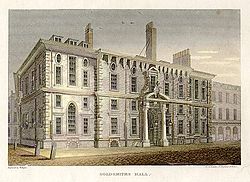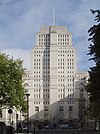Goldsmiths, University of London
- For the Memphis department store, see Goldsmith's. For other uses, see Goldsmith (disambiguation)
| File:Goldsmithsnew.gif | |
| Established | 1891 |
|---|---|
| Warden | Professor Geoffrey Crossick |
| Students | 7,615[1] |
| Undergraduates | 4,815[1] |
| Postgraduates | 2,585[1] |
| Location | , 51°28′27″N 0°02′07″W / 51.4743°N 0.0353917°W |
| Affiliations | University of London 1994 Group |
| Website | http://www.goldsmiths.ac.uk/ |
| Goldsmiths' Crest | |




Goldsmiths, University of London, is a constituent college of the University of London. Based in New Cross, London, Goldsmiths specialises in the teaching and research of creative, cultural and cognitive disciplines.
The institution was founded in 1891 as Goldsmiths' Technical and Recreative Institute by the Worshipful Company of Goldsmiths. It was acquired by the University of London in 1904 and was renamed Goldsmiths College. The word "College" was dropped from its branding in 2006 (however Goldsmiths College remains the institution's formal legal name).[2]
Location
The college is situated in New Cross, a highly populated area of south-east London with a considerable art and music scene. The college's main Richard Hoggart Building was originally designed as a school (opened in 1844) by the architect John Shaw Jr (1803-1870). In addition to this the college has built many more modern buildings to develop more of a campus, including the RIBA award-winning Rutherford Information Services Building completed in 1997 and the Ben Pimlott Building designed by Will Alsop and completed in 2005.
History
In 1891 the Worshipful Company of Goldsmiths set up a Technical and Recreative Institute, using the former Royal Naval School in New Cross as its base. In 1904 the Institute was acquired by the University of London and re-established as Goldsmiths' College. The apostrophe was removed in a rebranding in 1993. Shortly after the acquisition, in 1907, the college added a new arts building, designed by Sir Reginald Blomfield, to the back of the main building. During the Second World War it was decided to evacuate the students and faculty of the college to the University College, Nottingham (now the University of Nottingham), a decision that proved wise when the main building was struck by an incendiary bomb and gutted in 1940 (the building was finally repaired in 1947). During the 1960s the college experienced a rapid expansion in student numbers and the main building was expanded and the Lockwood Building, Whitehead Building, Education Building, Warmington Tower and St James's Hall were all built during this period in order to accommodate the new students. In 1988 Goldsmiths became a full college of the University of London and in 1990 received its Royal Charter. Among its wardens have been Richard Hoggart and Ben Pimlott.
Goldsmiths has been highly ranked by 'The Good University Guide' as the top London university to study Media and Communications plus Visual Arts. Goldsmiths' campus is noted for its rich architecture, including the Founders Building and Deptford Town Hall.
Research and teaching
Goldsmiths is best known for courses and research relating to creativity and culture, and has a reputation for producing visual artists, particularly those collectively known as YBA. This reputation was largely established by the influence of Michael Craig-Martin, Jon Thompson, Nick De Ville and Irit Rogoff as teaching staff. Its Sociology department has been important in the recent development of the discipline in Britain, with leading sociologists such as Paul Gilroy, Bev Skeggs, Nikolas Rose, Don Slater, Celia Lury, Les Back, Jeffrey Alexander and Kate Nash, working in the department in recent years. TERU, the Technology Education Research Unit, has been instrumental in understanding how design & technology works in schools; how to encourage learners towards creative interventions that improve the made world; and how to help teachers to support that process. Goldsmiths is well-known for Cultural Studies. The Media and Communications Department, as well as the Centre for Cultural Studies, house some leading scholars in this field including Scott Lash, Angela McRobbie, Sara Ahmed, Nick Couldry, John Hutnyk, and David Morley. In anthropology there are people like Stephen Nugent, Sophie Day, Catherine Alexander, Keith Hart and David Graeber, recently refused tenure at Yale because of his political commitments. The Goldsmiths anthropology department is also well known for its focus on visual anthropology. The realm of continental philosophy is represented with academics such as Howard Caygill, Alexander Düttmann and visiting professor Andrew Benjamin. Furthermore, in the area of Psychology there is Chris French a vocal sceptic of the paranormal who has appeared on television and radio on numerous occasions.
Organisation
Professor Geoffrey Crossick was appointed Warden of the College in 2005 following the death of Ben Pimlott, who had become Warden in 1998. Alumni are members of the Goldsmiths Society.
Student life
The College provides, amongst other things, catering facilities, a chaplaincy, a medical centre, a nursery and a gym for student use. Additionally, Goldsmiths Students' Union runs two bars, The Green Room and, above, The Stretch, which links across Dixon Road from the Richard Hoggart Building, hosts numerous entertainment events including karaoke, a quiz and bingo on Mondays, the legendary Club Sandwich club night open until between 2 and 3am on Wednesdays and a variety of other nights often featuring indie music. The union also provides student representation[1] and runs both a student magazine (Smiths[2]) and a radio station broadcast online and locally by FM (Wired[3]). All Goldsmiths students are also able to make use of the facilities of the University of London Union.
The university also owns 7 halls of residence which offer accommodation for students:
- Batavia Mews
- Chesterman House
- Dean House
- Loring Hall
- Surrey House
- Surrey House Annexe
- Raymont Hall
Goldsmiths recently featured on BBC online news as an example of how university life may be beginning to adapt to the financial pressures of tuition fees. "Instead of booze, bonding and even more booze, Goldsmiths, University of London, is ditching the "alcohol-centred, cheesy disco stereotype". Instead it wants to have a wider range of cultural events that will appeal to an increasingly-diverse student body."[3]
Sports, clubs, and traditions
Sports teams and societies are organised by the Goldsmiths Students' Union. The union runs 18 sports clubs, 11 of which compete in either University of London Union or BUSA leagues. In addition the union runs 35 societies, ranging from political societies (such as the Liberal Democrats society or the Respect society) and identity-oriented societies (for instance the Sikh society and the LGBT society) to interest societies (the Music Society, the Photography Society) and the more eclectic societies (the Made in Goldsmiths Society and the Somewhere Else Society).
An amateur opera company based in the college, Opera Gold, draws its cast from college members past and present.
Alumni
See also Category:Alumni of Goldsmiths, University of London.
Film
- Bhavna Malkani Documentary Film Director
- Tom MacRae Screenwriter & Author
- Paul Bush Experimental Film Director
Journalism
- Jo-Ann Furniss, Editor of Arena Homme Plus
- Hanna Hanra, Editor of The PIX
- Sarah Sands, sometime editor of the Sunday Telegraph.
- Keir Simmons, reporter, ITV News.
Literature
- Niven Govinden, novelist
- Hisham Matar, novelist
- Gladys Mitchell, author
- Julian Turner, poet
- R J Unstead, author
- Daisuke Fujisawa, playwright
- Mike Phillips (illustrator), author
- John Harvey (author), creator of Resnick series of crime novels
Music
- Richard William Brooks, musician of formerly the guitarist of black metal
- Damon Albarn, musician, frontman of Blur
- Rob da Bank, Radio 1 DJ
- Sam Beer, musician
- Tunday Akintan, creator of yorubeat music
- Jack Brymer, musician
- Ken Burton, musician, composer, arranger
- John Cale, musician
- Chris Corner, musician
- Graham Coxon, musician, member of Blur
- Patrick Frye III, musician, harpsichordist, composer, performance artist, poet
- Simon Hale, musician, composer, arranger
- John Illsley, musician, formerly bassist with Dire Straits
- Alex James, musician, member of Blur
- Patrick Jonathan, composer
- Linton Kwesi Johnson, poet, musician
- Kanya King, founder of MOBO awards
- Malcolm McLaren, music manager, notably of the Sex Pistols
- Brian Molko, singer with Placebo
- indigo Moss, London based alternative band
- Madeleine Shaw, opera star
- Pull Tiger Tail, New Cross based indie band
- John Wynne PhD, sound artist
Performers
- Emily Booth, actress and TV presenter
- Julian Clary, comedian
Politicians
- The Rt Hon Tessa Jowell MP, politician
- Cathy Jamieson MSP, Scottish politician
- Kerry McCarthy MP, politician
- The Rt Hon Lord Merlyn-Rees, politician
- Darren Johnson, Green Party politician
- Ben Horandi, Lord of Deptford
Visual arts
- Bernd Behr, artist
- Matthew Collings, artist and art critic
- Jess Cooper, artist
- Ian Davenport, artist
- Grenville Davey, artist
- Dawn Dupree, artist
- Angus Fairhurst, artist
- James Robert Ford, artist
- Lucian Freud, artist
- Anya Gallaccio, artist
- Antony Gormley, artist
- Damien Hirst, artist
- Gary Hume, artist
- Michael Landy, artist
- Sarah Lucas, artist
- Mark McGowan, performance artist
- Steve McQueen, artist
- Cathy de Monchaux, artist
- Ian Monroe, artist
- Gareth Morgan, artist
- Matt O'dell, artist
- Julian Opie, artist
- Stephen Park, artist
- Richard Patterson, painter
- Simon Patterson, artist
- Cyril Edward Power, artist and architect
- Mary Quant, fashion designer
- Alan Rankle, artist
- Bridget Riley, artist
- Anj Smith, artist
- Sam Taylor-Wood, artist
- Lai Tang, artist
- Mark Wallinger, artist
- Gillian Wearing, artist
- Vivienne Westwood, designer
- Catherine Yass, artist
- Walter Landor, pioneer in branding
See also
References
- ^ a b c "Table 0a - All students by institution, mode of study, level of study, gender and domicile 2005/06". Higher Education Statistics Agency online statistics. Retrieved 2007-03-31.
- ^ "Rebranding FAQs". Goldsmiths, University of London. Retrieved 2007-03-06.
it is now known as Goldsmiths, University of London. Apart from on formal, legal documents, you should now drop the word 'College' after Goldsmiths.
- ^ "Freshers' week - it's a fine art". bbc.co.uk. 29. Retrieved 2007-10-03.
{{cite web}}: Check date values in:|date=and|year=/|date=mismatch (help); Unknown parameter|month=ignored (help)

